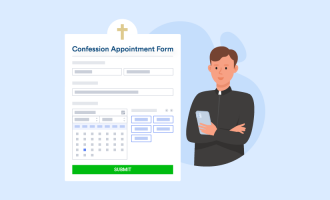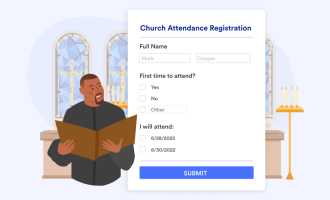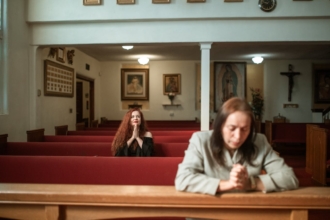Churches depend on donations to survive, and right now they’re being squeezed. Many are facing a financial shortfall in the wake of the coronavirus, writes David Paulsen with Episcopal News Service. With no in-person worship, there’s no one adding to the collection plate. Church leaders across the country are being forced to take action and brainstorm ways to make up for the losses.
Online church donations are an obvious solution. People still want to give; they just need a way to do so easily and securely.
But how to provide such a solution isn’t so obvious for a lot of ministers. That’s why we’re proposing the following simple solution to online church donations. Even churches that have never taken online donations can easily set up a system for themselves.
Set up a PayPal account
A payment processor is essential to take online church donations. PayPal is an easy method for churches to accept donations.
PayPal might not seem like the obvious choice for churches, writes Jason Vissers at partner referral site Merchant Maverick. Many church leaders aren’t even aware that PayPal offers a “donate” button, as well as a “buy” button; however, PayPal is one of the easiest ways to accept one-time or recurring donations.
If you use the standard version of PayPal, you’ll need to write donation receipts yourself, says executive director of The Gospel Coalition Canada, Wyatt Graham. If you enroll in the PayPal Giving Fund, however, receipts are provided automatically. Unfortunately, you’ll also lose the ability to offer recurring donations. Since most churches depend on regular, recurring donations, Graham recommends using the standard version of PayPal.
PayPal is a business. It charges for its services, and you may be tempted to pass these fees onto your congregation. There’s a good reason why you should absorb them, writes Lauren Hunter, publisher and editor in chief of ChurchTechToday. “The main reason to assume the cost of online giving is that there is a cost to forgoing online donations.”
First of all, you won’t get any financial support if you don’t provide your church members with a way to donate online. What’s more, Hunter says, is that you’ll see an increase in giving if you’re able to process online donations, which should more than cover the charges.

Promote your program and make it accessible
Next, you need to let your congregation know about your new donation system and give them access to it.
One of the easiest ways to do this is to integrate your PayPal account with an online donation form. Jotform has a ready-made church donation template that you can embed on your website or send directly to parishioners after your online sermon.
Spreading the word during online sermons has been incredibly beneficial for Rev. Alex Garncarz of Zion United Church of Christ in Peru, writes Tom Collins, a reporter for NewsTribune. Since Garncarz started an online donation program, tithing has increased by 30 percent. Even past and inactive members are donating.
It’s important to cover other bases too. Adding a link to your donation page on your church’s website is an ideal solution. This is what St. Agnes Church in Arlington is doing, reports Leslie Miller at The Arlington Catholic Herald.
“It has posted a plea front and center on its website urging parishioners to sign up for online donations,” she writes. “The goal is to transition from the traditional offertory envelopes to a system that can provide regular, reliable income to the parish, even when the parishioner isn’t at church.”
At the same time, don’t forget about members of your congregation who can’t give electronically. This might be a much bigger percentage of people than you think. For instance, Rev. C.J. Rhodes of Mount Helm Baptist Church in Mississippi says between 20 and 30 percent of his congregation can’t or won’t use technology.
You still need to provide ways for these members to give. More important, you need to go out of your way to stay in touch with them during times of uncertainty. In fact, Rhodes says the biggest cost of the pandemic on his church “has been the emotional and mental impact on the older members who depend on the church for social interaction and support.”
Explain the need for donations
Your congregation is likely suffering financially just as much, if not more than, your church. Their tithes are crucial but are also harder to come up with. You need to make a genuine and honest case about why they should continue to support you.
When donations are down, it can impact a church’s projects, points out Rev. E. Dewey Smith, senior pastor at House of Hope in Atlanta. His church needs donations to continue feeding senior citizens and first responders in Georgia, a program they put into place when the coronavirus hit the area. Other projects, such as scholarships and building a church in Rwanda, have been put on hold.
The problem is that most of your congregation won’t know about the issues surrounding a lack of donations, say Art Rainer and Blair Graham at The Gospel Coalition. They also won’t understand that donating online helps church staff keep their jobs and manage most of the administrative work from home. That’s why you need to be very clear with your messaging.
“Tell them during the online service, through email, and through social media,” Rainer and Graham advise. “Be repetitive with this message until you can gather again. As you communicate the need, provide the opportunity.”
Combine this message with exceptional care, writes Tim Forbes, vice president of products and marketing at web development services provider PICnet. Putting your congregation’s needs first builds loyalty, which can help protect donation levels. Do this by checking in on your congregants and offering support. Be honest about how the church is doing and, if asked, provide practical ways they can help.
Give thanks
Don’t let the communication stop when churchgoers hit the “donate” button. Thanking them for their donation isn’t just the right thing to do; it encourages them to donate again in the future.
The message doesn’t have to be complicated. Karen Engle at Faithlife suggests something as simple as “We received your gift. Thank you for partnering with us to help make disciples. We’re thrilled to see God’s people responding to his generosity.”
Send the thank-you message soon after donation, advises Kristine Miller, partner at church financial consultancy Horizons Stewardship. It should go out within 48 hours. Also, make sure you don’t ask donors for more money before you thank them for their last gift. Such overzealousness has been correlated with decreases in donations.
PayPal makes it easy to write notes of acknowledgment and gratitude. The payment provider includes donor information with each transaction, so all the information you need is at your fingertips, writes CJ Orr, vice president at Orr Group, a strategic fundraising firm. When you integrate your PayPal account with Jotform, you can set up an autoresponder to automatically email thank-you letters to donors.
Image by: rupixen.com, Kelly Sikkema



















Send Comment:
1 Comments:
More than a year ago
Good organization and good activities,